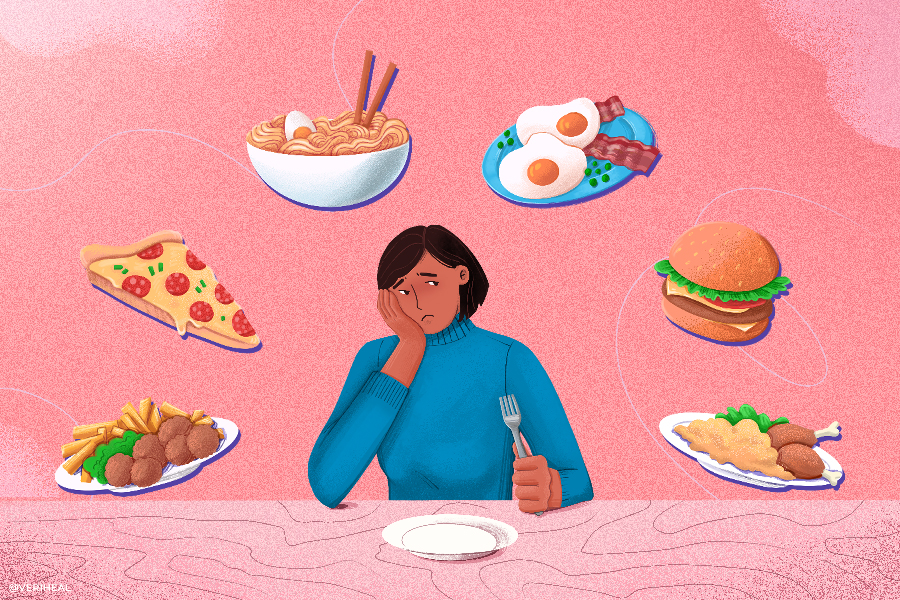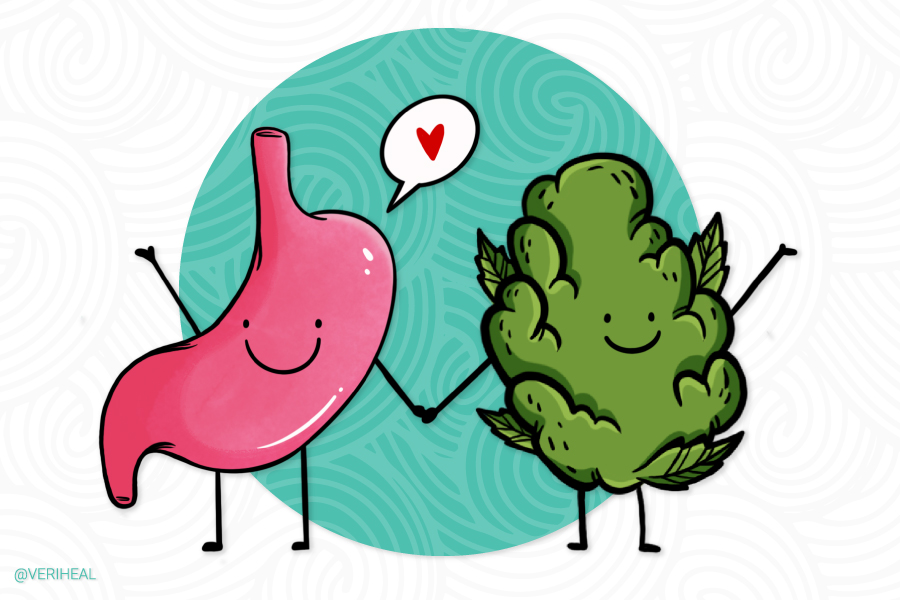Treating Eating Disorders with Cannabis
- Eating Disorders: Signs, Symptoms and Types
- Eating Disorders: Causes and Complications
- Eating Disorders Treatment: Can Cannabinoids Provide Relief?
- The Role of the Endocannabinoid System in Treating Eating Disorders
- What Preparations of Cannabis are Best for Eating Disorders?
- Talk to Your Doctor About Medical Cannabis
- Complementary Treatments Worth Discussing With Your Doctor
According to the National Association of Anorexia Nervosa and Associated Disorders (ANAD), 9% of the U.S. population (equivalent to 28.8 million Americans), will battle some kind of eating disorder during their life (3). Eating disorders present a global health issue, primarily in women but also in male, transgender, and gender non-binary people. This category of disorders constitutes any of a number of unique psychological disorders characterized by abnormal or disturbed eating habits.
The American Psychiatric Association’s Diagnostic and Statistical Manual of Mental Disorders, fifth edition (DSM-5), describes eating disorders as problematic mental health conditions that generally demand medical and psychological intervention.
Statistics cite that between the years 2018 to 2019, approximately 3,110 people in the U.S. lost their lives as a result of binge eating disorder, 2,680 from anorexia nervosa, 980 from bulimia nervosa, and another 3,430 died from other eating disorders (4).
The National Eating Disorder Association states “Young people between the ages of 15 and 24 with anorexia have 10 times the risk of dying compared to their same-aged peers (13).” They also report that “Males represent 25% of individuals with anorexia nervosa, and they are at a higher risk of dying, in part because they are often diagnosed later since many people assume males don’t have eating disorders.” And that is just the association between men and anorexia, not to mention all of the other potential eating disorders and people of different gender identities who are often left out of such data reporting.
Treatment for eating disorders usually includes a combination of nutrition education, psychological therapy, medical assessment and, in some cases, doctor-prescribed medication or even hospitalization in severe cases. Since cannabis has a reputation for “the munchies” (increased appetite), it is unsurprising that more people with eating disorders consider using medical cannabis.
Although it is not recognized as an approved treatment or cure for eating disorders, cannabis could provide a whole host of benefits when used in conjunction with conventional forms of therapy.
Eating Disorders: Signs, Symptoms and Types
There are various types of eating disorders, with the symptoms of each varying. Covered below are the different kinds of eating disorders and the symptoms of each:
Anorexia Nervosa
Clear symptoms of anorexia nervosa include:
- Weak bones (osteopenia or osteoporosis)
- Fine hair growth covering the entire body
- Decreased iron levels
- Reduced blood pressure
- Constipation
- Yellowish and/or dry skin
- Brittle nails
- Muscle weakness
- Lower-than-normal body temperature
- Low energy levels
- Constant feeling of being cold
- Slowed breathing/pulse
- Period absence (in biological females)
People who struggle with eating behaviors that mirror anorexia symptoms are described by MayoClinic as having “abnormally low body weight, an intense fear of gaining weight, and a distorted perception of weight.”
Binge eating disorder (BED)
When you lose control of your eating and overindulge in a short period of time (to the point that you feel uncomfortably full), you may be experiencing BED. This is especially true if you feel guilty and regretful after each binge. People with this disorder have an increased risk of developing type 2 diabetes, high cholesterol, high blood pressure, digestive problems, and heart problems.
Bulimia
Deliberately purging, such as vomiting, using laxatives, or excessive exercise, after binge eating a large amount of food in a small period of time is known as bulimia. Symptoms of bulimia include:
- Dehydration
- Decaying/sensitive teeth
- Heartburn
- Kidney failure
- Stomach and/or intestinal pain
- Swollen glands in the neck/beneath the jaw
Patients may be more prone to metabolic derangements, electrolyte imbalances, and other serious comorbid conditions.
Other specified feeding or eating disorders (OSFED)
If your condition does not match any of the aforementioned symptoms and types of eating disorders, or if you have a handful of symptoms from one or more of the above eating disorders, your condition may fall under the broad term of OSFED. Medical conditions that fall into this category include:
- Anorexia athletica
- Atypical anorexia
- Body dysmorphic disorder
- Night eating syndrome
- Food-avoiding behaviors
- Picky eating
- Eating disorders associated with type-I diabetes.
Eating Disorders: Causes and Complications
Scientists haven’t yet pinpointed the exact causes of eating disorders, nor have they managed to determine the type of people who are most likely to be affected by an eating disorder of some kind. Typically, most healthcare professionals agree that eating disorders are fairly complex illnesses that arise from a combination of biological, psychological, and environmental factors.
The pathways that might lead to the development of an eating disorder include environmental, genetic, and social factors. Some examples include:
- Age
- Excessive dieting
- Engaging in extracurricular activities
- Having a family history of eating disorders
- Poor psychological health
- Peer and social pressure
- Stressful life transitions
Along with the physical side effects of eating disorders, many people also commonly endure emotional and psychological problems, including:
- Anxiety disorders
- Autism spectrum disorder
- Mood and personality disorders
- Depression, including increased risk of suicide and suicide attempts
- About 26% of people with eating disorders attempt suicide
- Impulsive behavior, such as impulsive spending habits
- Low self-esteem
- Obsessive compulsive disorder
- Perfectionism
- Alcohol and substance use disorders
- Relationship troubles (3)
People with eating disorders may also experience severe health problems due to a lack of essential nutrients, vitamins, and minerals. Some examples of commonly reported health problems include:
- Anemia (iron deficiency)
- Heart problems, e.g. abnormal heart rhythms, mitral valve prolapse, or heart failure
- Bone loss (osteoporosis)
- Muscle loss
- Absence of a period (in biological females)
- Reduced testosterone levels
- Gastrointestinal problems, e.g. bloating, constipation, or nausea
Eating Disorders Treatment: Can Cannabinoids Provide Relief?
According to a study published in Cannabis and Cannabinoid Research, frequent cannabis consumption could lead to reduced BMI (1). Although there is no clear connection between cannabinoid use and weight maintenance, there are a wide range of theories highlighting the reasons why cannabinoids may be useful for maintaining healthy appetites.
Cannabis’ active compounds, cannabinoids, have conflicting effects on eating and metabolism. Some studies support the use of certain cannabinoids like THC as an appetite and metabolism-booster. An increased metabolism results in burning fat quicker and subsequent fasting insulin levels drop.
This study published on PubMed found that regular and repeated exposure to the plant’s primary psychoactive compound delta-9 tetrahydrocannabinol (THC) boosts appetite and calorie intake in the short-term (8). On the other hand, long-term use of THC could diminish CB1 receptor availability, resulting in “long-term effects that more than offset the short-term increase in energy stores that follow acute exposures.”
Furthermore, the body’s sensitivity to the effects of sugar may be amplified when under the influence of cannabis, as shown in this study. In fact, according to MedicalNewsToday, marijuana users may have increased insulin sensitivity than non-users. Consequently, the brain and muscles may use and burn more sugar (10).
The cannabinoid tetrahydrocannabivarin (THCV) is also gaining a lot of new interest for treating obesity and diabetes, and is cannabidiol (CBD). CBD has been shown to help control blood-sugar levels and reduce the fat production of fat, all the while minimizing inflammation caused by insulin resistance (5, 11)
The Role of the Endocannabinoid System in Treating Eating Disorders
The endocannabinoid system (ECS) is naturally built-in to the body of all living mammals and it plays an integral role in regulating appetite. The ECS produces and uses cannabinoids to manage a variety of functions, including digestion, immune response, sleep, memory, and appetite.
Only when a cannabinoid attaches to one of the system’s cannabinoid receptors (CB1 or CB2) can the ECS do its job. CB1 and CB2 receptors can bind to endocannabinoids, which are naturally produced by the human body. The receptors can also bind with phytocannabinoids, which are marijuana-derived compounds.
CB1 receptors activated by THC stimulate appetite and calorie consumption in the short-term, but may actually burn more energy in the long-term. Overall studies into cannabis and eating disorders are still very limited and the ones that exist are of low-quality and do not investigate all eating disorders.
A 2020 review going through over 1200 anorexia nervosa studies found only one was well-designed, involving delta-9-THC and dronabinol (synthetic THC), and showed that only dronabinol added a weight increase of an added 1 kg over 4 weeks over placebo (12). High THC did not have an effect on weight gain in anorexia nervosa in this study. More high-quality studies like these are needed to show how THC, synthetic THC, or whole-plant cannabis formulations may help with measurable end points like weight gain and comorbid psychiatric disorders like depression, anxiety, and mood or personality disorders (7).
Research published in PubMed under the article title, “The Role of the Endocannabinoid System in Eating Disorders: Pharmacological Implications,” (Eva M Marco et al. Behav Pharmacol. 2012) attests that the ECS is deregulated in people with eating disorders (9). Because of this, cannabinoid agonists should be considered safe and effective tools in the management of such disorders.
What Preparations of Cannabis are Best for Eating Disorders?
One of the main appeals associated with medical cannabis use to treat eating disorders is the diversity in terms of product options. Various cannabis preparations are available:
- Edibles
- Pills, capsules, and tablets
- Powder Cannabis powder
- Transdermal Patches
- Vapes or vaping whole flower
- Tinctures
Talk to Your Doctor About Medical Cannabis
To better understand exactly what type of eating disorder you are dealing with, as well as to determine whether you are at risk for severe complications, doctors use physical and psychological evaluations to diagnose eating disorders. Additionally, they will use lab tests to look for metabolic abnormalities to see how severe it is and prevent serious complications.
Medical professionals that treat eating disorders include medical doctors, nutritionists and dieticians, or mental health professionals such as psychiatrists, psychologists, and social workers.
After a diagnosis, you can begin discussing the medical uses of cannabis-based treatment options with a doctor. However, it’s important to note that cannabis should not be used as a substitute for other types of doctor-prescribed medications.
Complementary Treatments Worth Discussing with Your Doctor
The terms “complementary medicine,” “complementary and alternative medicine,” and “complementary therapies” relate to a varied array of healing resources designed to amplify the body’s natural healing capabilities.
Examples of complementary medicine that are generally welcomed in cases of eating disorders as a way of changing mental attitudes toward food and self-image include biofeedback, guided meditation, massage, reiki therapy, music therapy, and the use of dietary supplements. In cases of anorexia nervosa and other eating disorders, the family intervention approach has also proven to be effective and crucial for long-term recovery.
This clinical trial, published in Einstein (São Paulo) highlighted some more effective complementary medicine approaches to anorexia, including dialectic behavioral therapy, cognitive behavioral therapy, interpersonal psychotherapy, support therapy, and self-help manuals (2).
Since women with bulimia have been shown to have a lower-than-normal response in brain regions that are connected to the dopamine-related reward circuitry, the use of cannabinoids could be worthwhile for increasing dopamine neural activity (6).
Moreover, cannabis’ anxiolytic effects could help to diminish the mental illness and psychiatric disorders that sometimes accompany an eating disorder. Consequently, this could result in a better relationship with food and social eating.
Keep in mind that while medical marijuana and other complementary medicines can prove beneficial for you or a loved one with an eating disorder, it’s important that you continue using any medication(s) and treatments that are prescribed by your doctor.
Note: The content on this page is for informational purposes only and is not intended to be professional medical advice. Do not attempt to self-diagnose or prescribe treatment based on the information provided. Always consult a physician before making any decision on the treatment of a medical condition.
1. Clark, T. M., Jones, J. M., Hall, A. G., Tabner, S. A., & Kmiec, R. L. (2018, December 21). Theoretical explanation for reduced body mass index and obesity rates in cannabis users. Cannabis and cannabinoid research. Retrieved September 27, 2022, from https://www.ncbi.nlm.nih.gov/pmc/articles/PMC6340377/#:~:text=The%20present%20study%20summarizes%20the,rates%2C%20despite%20increased%20caloric%20intake
2. Costa, M. B., & Melnik, T. (2016). Effectiveness of psychosocial interventions in eating disorders: An overview of Cochrane Systematic Reviews. Einstein (São Paulo), 14(2), 235–277. https://www.ncbi.nlm.nih.gov/pmc/articles/PMC4943360/
3. Eating disorder statistics: General & Diversity stats: Anad. National Association of Anorexia Nervosa and Associated Disorders. (2022, June 8). Retrieved September 27, 2022, from https://anad.org/eating-disorders-statistics/
4. Elflein, J. (2022, February 15). Total number of deaths due to eating disorders by condition U.S. 2018-2019. Statista. Retrieved September 27, 2022, from https://www.statista.com/statistics/1230552/us-deaths-due-to-eating-disorders-by-condition/
5. Fearby, N., Penman, S., & Thanos, P. (2022). Effects of Δ9-tetrahydrocannibinol (THC) on obesity at different stages of Life: A literature review. International Journal of Environmental Research and Public Health, 19(6), 3174. https://www.ncbi.nlm.nih.gov/pmc/articles/PMC8951828/
6. Frank, G. K. (2015). Advances from neuroimaging studies in eating disorders. CNS Spectrums, 20(4), 391–400. https://pubmed.ncbi.nlm.nih.gov/25902917/
7. Kayser, R. R., Snorrason, I., Haney, M., Lee, F. S., & Simpson, H. B. (2019). The endocannabinoid system: A new treatment target for obsessive compulsive disorder? Cannabis and Cannabinoid Research, 4(2), 77–87. https://www.liebertpub.com/doi/10.1089/can.2018.0049
8. Kirkham, T. C. (2005). Endocannabinoids in the regulation of appetite and body weight. Behavioural Pharmacology, 16(5-6), 297–313. https://pubmed.ncbi.nlm.nih.gov/16148436/
9. Marco, E. M., Romero-Zerbo, S. Y., Viveros, M.-P., & Bermudez-Silva, F. J. (2012). The role of the endocannabinoid system in eating disorders. Behavioural Pharmacology, 23(5 and 6), 526–536. https://pubmed.ncbi.nlm.nih.gov/22785439/
10. MediLexicon International. (n.d.). Marijuana and diabetes: Benefits, risks, and legality. Medical News Today. Retrieved September 27, 2022, from https://www.medicalnewstoday.com/articles/316999
11. Penner, E. A., Buettner, H., & Mittleman, M. A. (2013). The impact of marijuana use on glucose, insulin, and insulin resistance among us adults. The American Journal of Medicine, 126(7), 583–589. https://www.amjmed.com/article/S0002-9343(13)00200-3/fulltext
12. Rosager, E. V., Møller, C., & Sjögren, M. (2020). Treatment studies with cannabinoids in ANOREXIA NERVOSA: A systematic review. Eating and Weight Disorders – Studies on Anorexia, Bulimia and Obesity, 26(2), 407–415. https://link.springer.com/article/10.1007/s40519-020-00891-x
13. Statistics & Research on Eating Disorders. National Eating Disorders Association. (2021, July 14). Retrieved September 27, 2022, from https://www.nationaleatingdisorders.org/statistics-research-eating-disorders









